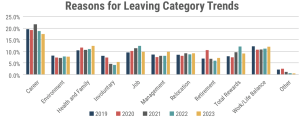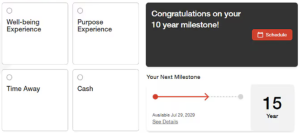Right now, a casual read of the HR press reveals there’s a lot of conflicting messages around the topic of employee retention (or employee attrition – depending on whether your glass is half full or half empty!)
Some workplace commentators say we’ve already entered a period that is already being called the ‘Great Stay’ – where employees are looking around at the general state of the economy, and are making an assessment that now is not the time to be making rash moves and quitting their reasonably secure role.
Thanks to slower wage growth (and a pay gains of just 5% for job switchers – the lowest for two years, according to ADP), staff have reportedly got fewer $reasons to jump ship and are opting to stay put.
And yet by contrast contrast, however, there are those that equally claim the ‘Great Resignation’ is still rumbling along, and employers are still losing good people in numbers they rather wouldn’t.
They cite figures which show 45 million workers chose to quit their job in 2023 (which equates to some 27% of workers), while polls indicate nearly half (46%) of employees say they have- or will consider leaving their jobs in what’s left of this year – a figure that’s more than during the so-called ‘Great Resignation’ of the Covid-19 years. Historically, quit rates peak in November, so many employers are potentially bracing themselves for that.
So what’s the real picture?
Well, for sure, quit rates are still historically high. They’re lower than in 2021 and 2022, but higher than 2020, and since 2014, quit rates have increased 37%.
All-told US companies spent a – wit for it – staggering $900,000,000,000 replacing employees who quit their jobs last year alone.
Improving retention

With an ongoing skills shortage, and a ‘Great Stay’ that is less easy to pinpoint most companies – it seems – do want to do more to increase their retention rates.
Data from the Work Institute’s ‘2024 Retention Report’ (above) reveals most people quit their job to enhance their career (17.4%), although closely following this were reasons including health and family (12.3%) and work/life balance (11.9%).
So how can employers boost retention of the people they want to keep?
Rewarding length of service?
One – dare we call it, old-school – technique of yesteryear was to actually reward staff for long-service – typically in big number increments – five, ten, 15, 20 year increments.
It made perfect sense.
Staff felt valued, recognized, and respected by their peers.
They got financial or physical rewards that actually meant something to them.
Reaching the next longevity milestone was something to aim for, and while it may not have been the be-all and end-all reason that kept them with an organization, it will have certainly helped – especially if the next, upcoming reward involved things like share options, which they’d lose out on if they left before their next award.
So is it time to bring back long-service?
For many HR professionals, this concept probably seems outdated simply because job-hopping now appears to be the norm.
In the decade between 2012-2022, for example, average job tenure fell 11% from 4.6 years in 4.1 years, with those between the ages of 25-34 staying the shortest amount of time – just 2.8 years (down from 3.3 years).
To put it another way, just for someone now to reach five years’ service is probably an amazing result – the equivalent (maybe) of someone reaching 10 or 15 years’ service a generation ago.
However, not everyone’s given up on longevity of service as something to celebrate.
PwC introduces long of service awards


On 1st July this summer, accountancy firm PwC launched ‘My Milestone Rewards’ – a new program available to staff in the US and Mexico, which specifically recognizes length of service with a set of flexible rewards that people can choose between.
Although it still incorporates traditional year-based milestones, the modern twist is that staff get to select the reward they want themselves, from a wide selection of offerings.
So, what exactly is the program about; what does it comprise; and will it improve retention rates?
TLNT decided to talk to Kim Jones, PwC’s US talent strategy and people experience leader to find out:
Q: Tell me more about why My Milestone Rewards came to be introduced?
A: “It came about because we wanted to offer more personalized rewards. We know the value of offering people agency about how they receive their rewards and recognition, and so we definitely wanted to add this element to it. Significantly, this reward is indeed based on tenure – whereas previously, we offered reward based on people who got promotions. It wasn’t like there was a big groundswell of demand for people demanding a reward for tenure, but it was as much about designing a way for as many people to be included in it.”
Q: What’s the specifics of My Milestone?
A: “Rewards are offered at milestone levels of tenure: three years; six years, ten years,15 years and then every five years after that. When each milestone is reached, employees can choose the rewards and experiences that matter most to them. Options exist for wellbeing and purpose-driven experiences, in addition to time away on vacation or cash.”
Q: Is there a theme for the rewards?
Q: “Yes, it’s very much in the wellbeing space, continuing our ‘Work Well, Be Well’ mission that we introduced a few years ago. Be Well, Work Well is about forming everyday healthy habits that help fuel our six dimensions of well-being: physical, emotional, mental, spiritual, financial and social, which are proven drivers of performance, fulfillment and engagement. This goes beyond the traditional employee wellness programs focused mostly on physical health; it’s a holistic approach to a more happier and healthier life.”
Q: Can you give me some examples of what people can choose?
A: “Wellbeing experiences include personalized vacations centered around wellbeing at a variety of global locations. One example includes a wellness vacation featuring wellbeing experiences such as a cooking class for two at a restorative resort in Hawaii. Purpose-driven experiences offer culturally immersive vacations combined with volunteer opportunities around the world. And example of this includes a ten-day wildlife conversation trip volunteering in South Africa to help protect wildlife at the Great Kruger National Park.
Q: Presumably the level of reward gets better the longer people stay?
A “Yes. Obviously, the size and scale of the rewards escalate the longer the tenure period. But, what’s key about this is that we don’t have a preference for what people take – it’s more what’s important for them at their particular stage in life – for instance, they may just want cash, or they may want time off to see their family.”
Q: You’re starting this at what some might see as a fairly low three-years’ tenure. Is this a reflection that people don’t stay as long as they used to in jobs anymore?
A: “The fact it starts earlier than traditional longevity awards was definitely intentional. We initially thought we’d start it as five years’ service, but we decided that for many people, even this feels like a long time – especially for people early in their careers. The added benefit is that by starting at three years, pretty much 100% of people should be eligible for an award over time.”
Q: Do you think this will have any real retention element?
A: “Yes, I’m willing to bet that it will improve retention, but I’m equally convinced it will also act as a talent attraction tool too.”
